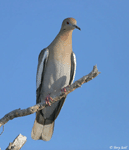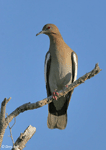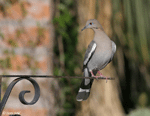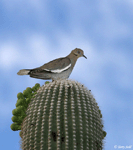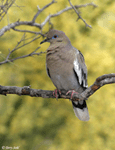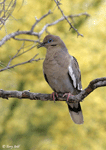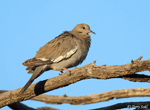| Length: 11 - 12 inches | Wingspan: 17 - 18 inches | Seasonality: Rare visitor |
| ID Keys: Similar to Mourning Dove but with large white wing patches, white tips on outer tail feathers. | ||
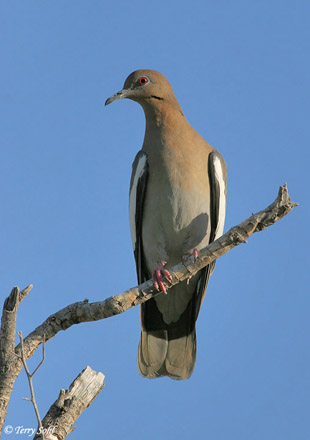 The
White-winged Dove is primarily a native of the southwestern U.S., but they are
adapting to a human presence and have expanded their range northward in recent
decades. While most migrate southward in the winter, some have learned to
move to suburban areas to take advantage of bird feeders and other
human-introduced food items. They have been expanding in range in recent
years, and have made semi-regular appearances in Nebraska. In South Dakota,
sightings have also become increasingly common, although still rare.
The
White-winged Dove is primarily a native of the southwestern U.S., but they are
adapting to a human presence and have expanded their range northward in recent
decades. While most migrate southward in the winter, some have learned to
move to suburban areas to take advantage of bird feeders and other
human-introduced food items. They have been expanding in range in recent
years, and have made semi-regular appearances in Nebraska. In South Dakota,
sightings have also become increasingly common, although still rare.
Habitat: Can be found in a variety of semi-open habitats, including shrubland, deserts, chaparral, open oak woodlands, farmland, and suburban areas.
Diet: Primarily feeds on seeds, fruits, berries, and occasionally nectar.
Behavior: Will forage on the ground or in trees and other vegetation. In desert areas of the southwest, they are important pollinators of Saguaro cacti, and are often seen at the tops of these plants, feeding on the flowers and fruit.
Breeding: Non-breeder in South Dakota to date. In their breeding range, the nest of a White-winged Dove is a flimsy platform of sticks, placed low in a bush or small tree. The female usually lays 2 eggs, and both parents help to incubate them. The eggs hatch after about 14-18 days, with the young fledging from the nest after about two weeks.
Song: Low-pitched cooing. Click for White-winged Dove song.
Migration: Summers in the southwestern U.S. and along the Gulf Coast. Most move southward for the winter, although those in southern Florida appear to be permanent residents and those in suburban settings are less likely to migrate.
Interactive eBird map: Click here to access an interactive eBird map of White-winged Dove sightings
Similar Species: Mourning Dove
Conservation Status: Numbers and range are expanding as they become accustomed to a human-altered environment. There is evidence that range expansion to the north is occurring, and they've been found increasingly in states such as Nebraska, with sightings now also starting to occur in South Dakota. Given the large population size, the broad geographic range, and favorable population trends, the IUCN considers the White-winged Dove to be a species of "Least Concern".
Bird Feeders: Will attend feeders for small seeds and fruit
Further Information: 1) Arizona Sonoran Desert Museum - White-winged Dove
2) WhatBird - White-winged Dove
3) Audubon Guide - White-winged Dove
Photo Information: May 6th, 2008 - Near Tucson, Arizona - Terry L. Sohl
Additional Photos: Click on the image chips or text links below for additional, higher-resolution White-winged Dove photos.
| Click on the map below for a higher-resolution view |
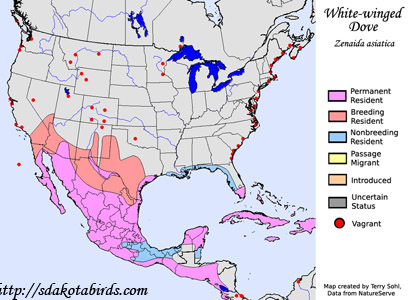 |
| South Dakota Status: While they are expanding their range from the southwestern United States, they are still only very rare visitors to South Dakota. |
Additional White-winged Dove Photos
Click for a higher-resolution version of these photos
